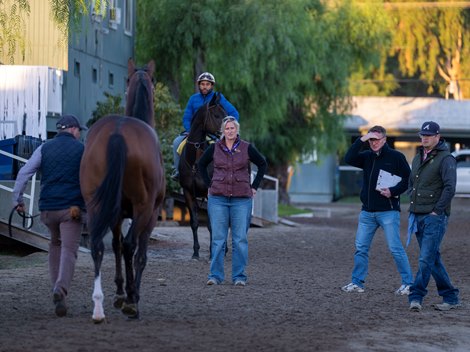In the early part of 2019, during a spike in equine breakdowns at Santa Anita Park and negative publicity that followed, trainer Tim Yakteen, like others, would be asked about the incidents even when he was outside the racetrack.
“Going to Starbucks—you just wanted to slip in and slip out. You didn’t want to talk about it,” the Southern California-based trainer said, noting his self-awareness.
Five years later, California has dramatically reduced its equine fatalities following rule and cultural changes, and Yakteen has forgone dodging questions from casual observers to publicly laud the safety improvements. Santa Anita, which recently wrapped up its Hollywood Meet, had only two musculoskeletal equine fatalities over nearly six months of racing from Dec. 26 to June 17. This reflected a 99.97% safety mark from the 6,678 horses that raced.
Santa Anita, which is among the most used racetracks in the country for morning training, also had five musculoskeletal fatalities during training over the first half of the year.
“The changes that took place were—and are—something that I’m very proud of,” Yakteen said June 25 at the 11th Welfare and Safety of the Racehorse Summit from the Longship Room at Kroger Field in Lexington.
Southern California trainer Tim Yakteen
During a two-person panel conversation titled “5 Years Later—an Update on Santa Anita Safety Reforms” alongside Dr. Dionne Benson, chief veterinary officer for 1/ST Racing, Yakteen gave his perspective on safety and regulatory procedures in California.
Read More About RaceTrack Safety Initiatives in BloodHorse’s Top Priority Series
Many of California’s rules have been mirrored in regulations enacted across much of the nation by the Horseracing Integrity and Safety Authority. Though Yakteen initially suspected the new rules in California would present a challenge, he said he found the transition to adapting to them to be “very smooth.”
Those rules aimed at improving horse safety and welfare—enacted with joint efforts by stakeholders in California, ranging from horsemen to tracks and the state regulator, the California Horse Racing Board—revamped medication regulations. Additionally, changes led to veterinary interventions, workout sign-ups, monitored training, increased access to advanced diagnostics, and support for injured racehorses.
For the latter, that meant that horses with closed single distal limb injuries were radiographed prior to euthanasia and potential surgical options examined.
Benson said that one of those options, a fetlock arthrodesis program that began in 2020, has been a success. In that procedure, plates and screws are utilized to stabilize a joint by fusing bones, eliminating movement and providing stability.
Decades ago, Benson noted that sometimes just the most valuable racehorses went through the procedure. Some felt this fusion could detract from a horse’s quality of life.
But she said that over the last 4 1/2 years of this surgical program in California, 16 out of 24 horses that have gone through this procedure have “been saved because of it.”
She showed a video of several fulfilling other tasks in second careers, commenting about one, “I tried to adopt this horse; somebody beat me to it.”
Though racing fatalities dropped during racing at Santa Anita Park over the past six months, overall fatalities in the state are up in 2024 compared to the first half of the year of both 2023 and 2022. However, the figures are far from 2019, counting all tracks and training centers across breeds, CHRB executive director Scott Chaney noted last week during a board meeting.
Chaney also noted during the CHRB meeting that two upcoming regulations will go into effect Jan. 1. The more notable of the two is requiring that an attending veterinarian perform diagnostic imaging within seven days of injecting a corticosteroid into a high-motion joint.
Changes that began in California that have spread elsewhere have also led to improvement in safety, Benson said.
She said 1/ST Racing, which in addition to running Santa Anita Park in California and now-shuttered Golden Gate Fields in the state, has seen a 40% decline in fatalities at its Gulfstream Park facility in South Florida after implementing required veterinary exam procedures for entry and workouts that were initially implemented in California.

Dr. Dionne Benson examines a horse at the 2023 Breeders’ Cup at Santa Anita Park
Both Yakteen and Benson acknowledged the veterinary costs of such examinations, but both deemed them worth the price. Yakteen said that close examinations of runners, including diagnostics, can spot physical issues at an earlier stage. This can mean less time on the sidelines for that horse in recovery.
“The sport is enjoyable when everyone comes back healthy,” Yakteen said.



)






